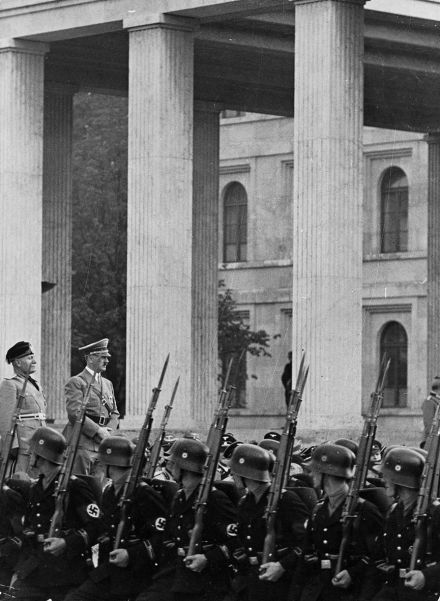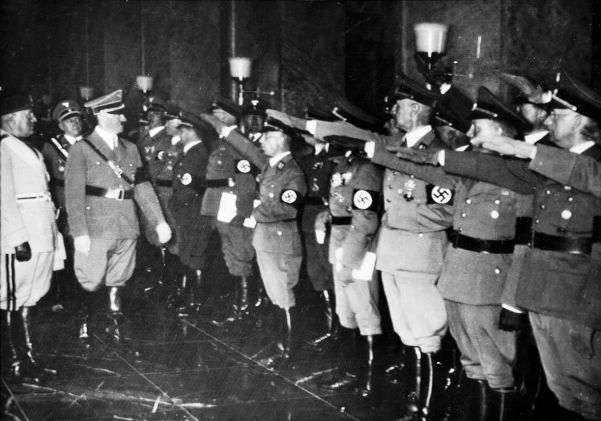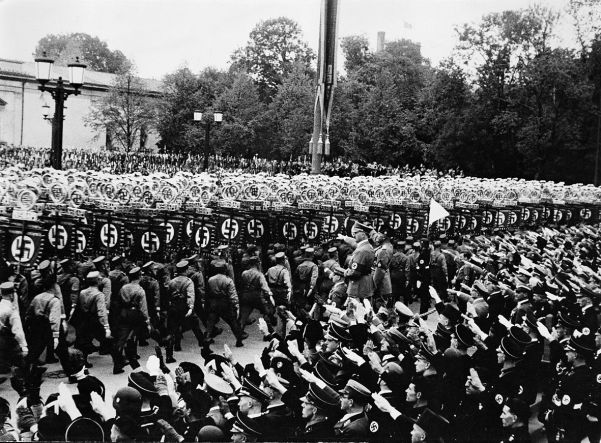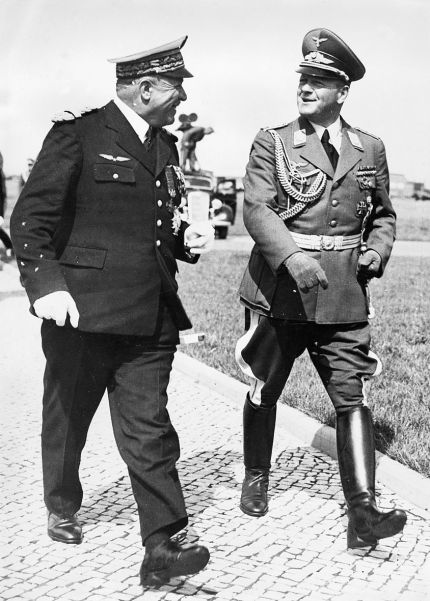6-13 September
Nazi Party, Rallies
Party Rally of Labour.
24 September
Germany, Diplomacy

As Mussolini boards the train in Rome for his visit to Germany, he wears a splendid uniform specially designed for the occasion: a grey-blue Corporal of Honour uniform with a cornflower blue sash across his chest and a black militia cap adorned with a red cord. His staff, which consists of Ciano, Alfieri, the minister of press and propaganda, Storace, the party secretary, and about 100 officials, journalists and subordinates, are also bedecked in finery. From Rome Mussolini’s train stops at Forli where he pauses for family kisses and well-wishes. His special nine-coach armoured train then progresses on its historic journey, which will be one of the pivotal moments in the history of the Third Reich and Fascist Italy.
When the train pulled into the Alps, it stopped for five hours during the night to give the Duce an opportunity for a rest.
25 September
Germany, Diplomacy




The following morning the train enters Austria. There, Chancellor Dr Kurt von Schuschnigg’s cabinet is deeply concerned at the possibility of the Duce’s assassination. This trip not only exposes him to the usual danger of anti-Fascist attacks, but also the bitter hatred of the Tyrolese as a result of Italy’s annexation of South Tyrol. Some 4300 Austrian soldiers have been stationed along the 160km (100 miles) of railway line, their backs to the “Mussolini Special” with orders to shoot to kill without question anyone suspected of bombing, shooting at or stoning the train. When Mussolini arrives in Innsbruck, the Duce openly admires the scenic beauty of the country.
At 08:52 hours Mussolini’s train stops at the German boarder town of Kiefersfelden. There, Reichsminister Rudolf Hess and the Italian Ambassador Attolico meet the Duce and board his special carriage. The trip from the German border to Munich is lined with Bund Deutscher Mädel (BDM - League of German Girls) and Jungvolk (Young People - junior division of the Hitler Youth) members, who muster on the platforms of every station to wave their welcome. As the train slowly enters the outskirts of Munich, the city seems aflame with masses of red, white and black swastika flags fluttering beside the warmer Italian combination of red, white and green. At 10:00 hours the train arrives at the station, and a smile lights Mussolini’s face. Everywhere he sees tall pillars surmounted by Roman Eagles and a spectacular scarlet and gold Caesarean festoons set off by Nordic fir and laurel. When the train halts he is the first to step off. Adolf Hitler and his group of diplomats, which comprise Dr Josef Goebbels, Minister of Propaganda; Heinrich Himmler, head of the German Police and commander of the SS; Dr Alfred Rosenberg, in charge of party ideological schooling; Baldur von Schirach, Reich Youth leader; Colonel-General Werner von Fritsch, Chief of Staff; Dr Robert Ley, Leader of the German Labour Front; Victor Lutze, commander of the SA; General Franz Ritter von Epp, Governor of Bavaria; Adolf Wagner, Gauleiter of Munich; Ernst Wilhelm Bohle, leader of Germans living abroad; Konstantin Hierl, Labour Corps leader; and a number of less known dignitaries. They exchange the Fascist salute with their Italian guest, then Hitler and Mussolini shake hands, who subsequently introduces the members of his immediate party. The Duce and the Führer march side by side through the station on a crimson carpet and emerge to the roar of heavy German guns crashing 21 times in salute. As they come in sight of the decorated Bahnhofplatz, a wide square in front of the station, they are met by the glitter of steel and standards from the army and Nazi honour detachments. Massed bands spontaneously break into “Giovinezza”, the Fascist hymn, and cheering squads set up rounds of “Heil Hitler” and “Duce,Duce!”
After an inspection of the guard of honour, which was comprised of one company each from the army, navy, air force, SS, Labour Corps and the SA, the dictators entered an open Mercedes. They were slowly driven through the Munich streets where double-lined SS troops stood shoulder to shoulder. Mussolini and his retinue were taken to Prince Karl Place where they would stay while in Munich. A short time later, Hess called on the Duce and escorted him to the Fuhrerhaus at 6 Prinzregentstrasse. At 11:32 hours the two leaders met for an extended conversation. Count Galeazzo Ciano and Baron Constantin von Neurath, the German Foreign Minister, also participated in these talks. The discussions were general rather than particular and all that emerged was a firm agreement on a friendly attitude towards Japan and the greatest possible support to Franco in Spain. At this time the Duce presented Hitler with a commission as a Corporal of Honour in the Fascist Militia, which had been created for himself alone. In turn the Führer bestowed upon the Duce one of Germany’s highest awards, the Eagle Order, Grand Cross in Gold with Diamonds, which was not to be repeated for any future holder.
The early part of the afternoon was spent touring the carnival-decked streets and palaces and laying wreaths on various Nazi monuments in the Bavarian capital. Among these was the Feldherrnhalle in Königsplatz, which held the bodies of 16 Nazi heroes killed in the 1923 Munich Putsch. The two leaders later attended a lunch at the Führerhaus with members of the Alt Kämpfer of the Party. The Königsplatz resounded to the stomp of boots as Mussolini looked on in admiration from his saluting base. He later commented to Hitler: “It was wonderful!”, as they stood side by side on the small reviewing stand in front of the Temples of Honour: “It couldn’t have been better in Italy.” This massive demonstration left an indelible impression on the Duce.
An afternoon reception was held in their honour at the Museum of German Art. Fräulein Leni Riefenstahl, feminine arbiter of the Nazi film world, gathered more than 100 of Germany’s most beautiful stage and cinema actresses for the occasion. Hitler proudly toured Mussolini through the new museum, pointing out favourite specimens and explaining at length his elaborate plans for beautifying Berlin, Munich and other cities. After the tour, the two dictators attended a tea in the museum’s restaurant. It is interesting to note, however, that at the tea the female glances were towards boxer Max Schmeling who was also a guest. At this time, Mussolini spoke of an impending visit to Rome by Hitler. “It will be an occasion for wearing my new uniform,” replied Hitler, commenting on his newly acquired rank of Corporal of Honour.
That evening Hitler and Mussolini boarded separate trains, lest perchance one wreck killed them both, which sped across Germany to the Baltic province of Mecklenburg-Schwerin.
26 September
Germany, Diplomacy


Hitler and Mussolini arrive in the morning at the little village of Lalendorf, near the centre of the manoeuvre area, to witness the final stages of post-World War I Germany’s greatest military manoeuvres. Hitler and Mussolini’s entourage are met at the station by high officials of the German defence forces, which are led by War Minister Werner von Blomberg, Air Minister Hermann Göring, the Army Chief of Staff, Colonel General Werner von Fritsch, and Naval Chief of Staff Admiral Erich Raeder. In an open touring car, Hitler and Mussolini dash from area to area observing the latest in artillery, infantry and armoured techniques. Throughout the lightning tour, they are cheered by German soldiers who are of the class of 1935. These troops are the first to have been called up when Hitler restored universal conscription to the German way of life.
At the conclusion of the manoeuvres, Hitler and Mussolini boarded a special train to Kröpelin, in the northwestern corner of Mecklenburg-Schwerin. There they inspected the new flying field at Wustrow, examined several new types of military aircraft and later observed air exercises. The famous slow-flying “Storch” was demonstrated by Major-General Udet, with Air General Milch as passenger. Flying the versatile aircraft at minimal speeds of 19-24km/h (12-15 mph), once again the Duce was visibly impressed. Up until now Mussolini had seen German art, laid wreaths on monuments, inspected honour guards and observed war games. He now wanted to inspect one of Germany’s most closely guarded secrets, the mighty Krupp munitions works at Essen. The German schedule had called for a short trip to Berlin from the Baltic for a triumphant welcome, but Mussolini’s insistence now called for the dictators to travel across Germany to Essen and then cross it once more, back to Berlin. Immediately German Minister of Propaganda and Public Enlightenment Dr Josef Goebbels broadcast to the astonished citizens of Essen that they were to deck their city with green branches and flags in honour of the Italian leader, who would arrive the next day. To ensure that all arrangements would be in readiness, he and several assistants rushed by special train to Essen.
27 September
Germany, Diplomacy


After travelling across Germany in separate trains, the Hitler and Mussolini specials rumble into Essen at 08:07 hours. Essen and Krupp have done themselves proud; all is in readiness. Due to security precautions, correspondents are not allowed to join in the tour while the Duce and Hitler inspect the hush-hush realm of munitioneer Dr Gustav Krupp von Bohlen und Halbach. At the company’s offices, the dictators are received by the director of Krupp, who presents the members of his family. He then explains the growth and organization of his gigantic concern. The party was then escorted to the main plant by car. There they see the production of artillery, tanks and every conceivable weapon of war. Mussolini is highly impressed by the discipline of the workers, scale of operation and tremendous output of weaponry. The Krupp inspection ends at 10:45 hours. Once again the leaders travel in separate trains from Essen.
Elaborate measures were taken with true German thoroughness to ensure that for the last 24km (15 miles) of the journey to Berlin, the two trains would run side by side, signifying the equality of the two revolutions. Before arriving at the station, Hitler sped ahead, enabling him to be on the platform to properly greet his guest. The arrival in the German capital was, as Count Ciano stated in his diary, “Triumphal”.
The first three days of the state visit had been for indoctrination, but the culmination was the welcoming in Berlin. Never before in German history had Berlin witnessed such a display. This spectacle dwarfed the Munich pageantry to the dimensions of a country fair. With the aid of professional stage designer Benno von Arendt, Berlin’s central sections were transformed into a prop fairyland. The city was decorated with thousands of German and Italian flags from the station at the Heerstrasse to the Presidential Palace in the centre of the city. A 38.4m (126ft) flag tower erected in Adolf Hitler Platz, midway between the railway station and the Brandenburg Gate, was bedecked with German and Italian flags 36.5m (120ft) long. The Pariserplatz before the Brandenburg Gate had two coloured water fountains and four massive towers covered alternately with Italian and German flags. Dusk fell as the leaders drove through the floodlit Brandenburg Gate onto the famous Unter den Linden. There, four rows of white, illuminated pylons, 10m (33ft) high bearing golden eagles and Nazi and Fascist emblems, glowed in the night. Banners in the German and Italian colours hung from rooftops to the pavements and in the Wilhelmstrasse. It is estimated that approximately 50,00 square metres (55,000 square yards) of bunting had been woven for the decoration of these two streets. As the crowds roared a welcome to the Italian dictator, Mussolini stood up to let himself be seen, obviously delighted with his reception. The Führer remained seated at his left, allowing his guest to enjoy the full glory of the moment. Work had ceased in Berlin at 16:00 hours on the day of the arrival, enabling the total population to be present. Hitler took personal precautions in the security measures to protect the Duce. Approximately 60,000 troops lined the route of travel. In some places they stood three and four deep. The city’s police was reinforced by detachments from Saxony. Plainclothes men mixed in the crowd while armed launches patrolled the River Spree. That evening a state banquet was held in Mussolini’s honour. Members of the government and all leading members of the party were present at the Berlin reception. Hitler, a strict vegetarian and teetotaller, nibbled throughout the banquet and toasted his guests with sweet German champagne.
28 September
Germany, Diplomacy
This day has been given as a national holiday. Mussolini visits the Arsenal Museum on Unter den Linden where he views mementos from previous wars.
He stood reverently for a few minutes before President von Hindenburg’s death mask. He and his party then motored to Potsdam near Berlin and inspected Sanssouci, Frederick the Great’s palace. After walking to the famous Garrison Church, Mussolini placed a wreath on the tomb of Frederick the Great. The Duce then returned to Berlin and called on the Italian Embassy and the headquarters of Fascio. There he was saluted by 25,000 Italian Fascists now resident in Germany and 3500 members of the Fascist youth organization. At noon he drove with Ciano and Bernardo Attolico, his new ambassador to Berlin, to Schorfheide 64km (40 miles) from Berlin. He then attended a luncheon given by Göring and his wife at their beautiful hunting lodge Waldhof Karinhall. It was at this time that he was presented with the Luftwaffe’s highest award, the Pilot-Observer Badge in gold with diamonds. Later he took afternoon tea with Dr Goebbels and then retired to the Presidential Palace where he dined privately that evening.
Simultaneously that day a mammoth demonstration was being organized on the Maifeld, the polo ground adjoining the Olympic Stadium. Since early that morning a crowd of approximately 650,000 had gone to the city’s outskirts and gathered before the official tribune. At 18:00 hours the Olympic Bell began to ring, signifying that Hitler and Mussolini were en route. Their arrival was announced by trumpets, while the large personal standards of the Duce and the Führer were hoisted on either side of the tribune. Despite threatening rain clouds, the crowd was good natured. Dr Goebbels mounted the speakers tribune and stated: “Three million people have taken part in this historic demonstration of the National Socialist movement, either along the route, on the Maifeld or in the stadium.” All of Germany’s radio stations were connected to the Maifeld speaker system. Twenty countries in Europe and North and South America were also united in the gigantic hook-up, which the Propaganda Ministry had arranged for this occasion. Great Britain did not accept the broadcast, however, and Russia was not invited to do so. As Dr Goebbels, the man who had supervised this engineering wonder, told the two dictators in presenting them to the audience: “The whole world is listening to you.”
Hitler was the first to speak to the German nation by wireless. He introduced the Duce: “What moves us most at the moment is the deep-rooted joy to see in our midst a guest who is one of the lonely men in history. These two men are not put to trial by historic events but determine the history of their country themselves.” Mussolini then stood up and climbed the podium to speak. Before him thousands of Germans arms rose in the Roman salute. Mussolini delivered his carefully prepared speech in fluent German, but with an Italian accent. In the midst of the Duce’s speech a darkening sky suddenly opened and a torrential rain fell on the Maifeld. Unfortunately, he became overcome by the excitement generated by the dynamic spectacle before him and spoke faster and faster. This, plus the sounds of the downpour, caused his words to be almost inaudible. His script was soon a sodden mass but he continued as the patient crowd became soaked to the skin. In the course of his speech the Duce pronounced: “Fascism has its ethical principles, to which it intends to be faithful, and they are also my morals; to speak clearly and openly, and, if we are friends, to march together to the end.” He also spoke of the awakening of Germany through the Nazi revolution, Bolshevism, the common enemy, and Germany’s friendly stand during the Ethiopian War. The speech ended with a stress on the 115 million Germans and Italians and the need for them to unite “in one single, unshakable determination”.
After the speeches, Hitler and Mussolini walked across the field to the Olympic Stadium. There, in the huge green and brown Olympic arena, marched the massed bands of three army corps. There were 4000 musicians in all, 33 brass bands, 25 fife and drum corps and 10 trumpet bands. They goose-stepped in perfect precision to the tune of “Preussens Gloria”, a favourite military march, and wheeled into three columns in the centre of the arena. The trumpet bands came from the cavalry and artillery and the rest of the units from the army, navy and air force. As the floodlights shone on them, the massed musicians sent forth strains of the great marches from Verdi’s “Aida”, for the Italians’ benefit, Wagner’s “Rienzi” for the Germans. Then the “Bavarian March Past” was struck up and from under an arch at the side of the Stadium, a battalion of torchbearing Schultzstaffeln appeared. They flowed into the arena like a living flame, wheeling halfway around, dividing and moving to each side in columns of four. These again divided and became streamlets of twos, which in turn divided, countermarched and passed each other in single file just as a second torchbearing battalion came from under the arch. The first battalion marched in single file around the arena and took rigid stations at its edges, approximately 3m (9ft) apart. The second battalion divided, subdivided and moved through the massed musicians forming with them a huge “M” with its base towards the dais on which Hitler and Mussolini stood. After this complicated manoeuvre, the musicians began a march to Beethoven. Simultaneously, three “honour companies” from the army, navy and air force entered. They goosestepped halfway around the arena, then wheeled to the front and came to attention. Their mounted commander came forward, faced the dais, and reported to Hitler: “1600 of your defence forces, Mein Führer.”
Outside the stadium, 50 concealed searchlights threw up long beams of light, forming “the tent of light” which was now a feature at German pageants. The troops came to present arms and the massed bands very softly played the German Army hymn, followed by the Italian national anthem, “Giovinezza,” “Deutschland uber Alles” and the “Horst Wessel Lied”.
As the spectacle came to an end, the rain began to fall once more. Standing equally unprotected, side-by-side, Mussolini made a remark to Hitler. Hitler made a gesture to a nearby SS officer, who threw rain capes around the shoulders of both leaders. The end of this massive pageant came when the huge swastika and Fascist standards, above the host and guest, were lowered as they departed from the stadium.
29 September
Germany, Diplomacy
The mornings activities are confined to placing a magnificent wreath at the German War Memorial on Unter den Linden by Mussolini, Count Ciano and Marshal Badoglio. After reviewing the guard of honour at the War Memorial, Mussolini marches past about 100 war invalids in self-propelled wheelchairs and salutes them. He then joins Hitler in a salute to 14,000 men of the army, navy and air force on Charlottenburger Chaussee. The parade, which is led by General Witzleben, commander of the Third Army Group, takes one hour and 20 minutes. Some 591 officers, 13,000 rank and file, 2000 horses, 600 motorized vehicles and 144 motorcycle units, all drawn from Berlin and neighbouring garrisons, pass by.
The army contingent was comprised of five infantry regiments, four artillery, one cavalry, besides pioneer, armoured, signal and machine-gun battalions. The air force contributed three motorized antiaircraft regiments, while the navy contributed two companies of cadets. During the parade an incident occurred that Mussolini later recalled: “During the military review the mace bearer was too quick and struck a soldier behind him on the head, and an artillery horse kicked over the traces and bolted right in front of the box. Hitler laughed and so did I. Then he turned to me and remarked confidentially, ÔI don’t like to think what’ll happen to the wretched private. Our perfect German organization will set in motion. The general will go for the colonel; the colonel will go for the major; the major will go for the captain; the captain will go for the lieutenant; the lieutenant will go for the sergeant-major; the sergeant-major for the sergeant; the sergeant for the corporal; and finally poor private!’” After the impressive review, Mussolini was taken to the Reich Chancellery for a farewell luncheon. He was then escorted to the Lehrter Station in Berlin. There, he and Hitler shook hands heartily and continued an animated conversation from his window after the Duce had boarded the train. Personal gifts accompanied him: three crates of geese presented by the curator of the Berlin Zoological Gardens. Hess, Hitler’s deputy, travelled with the Italian party as far as the German frontier. The Rome-Berlin axis had been pronounced for all the world to see.
